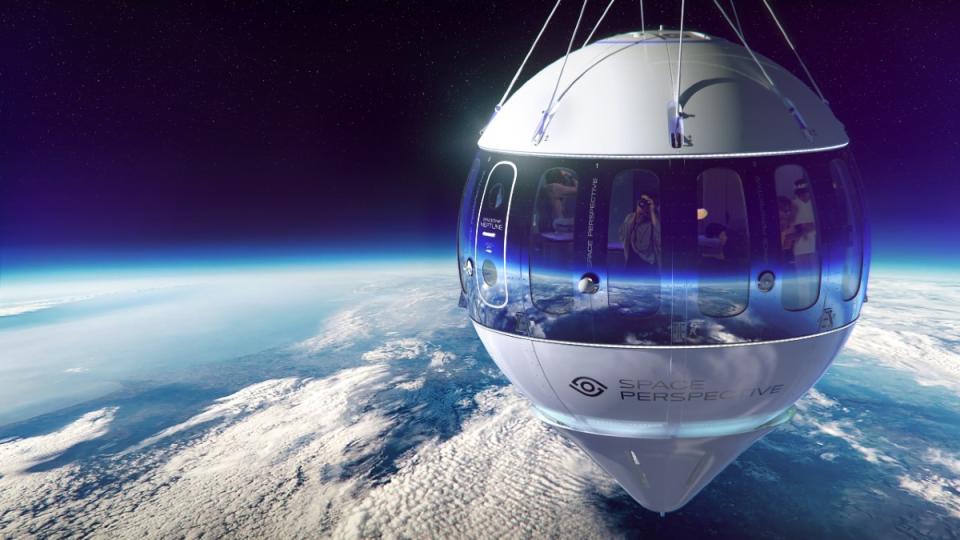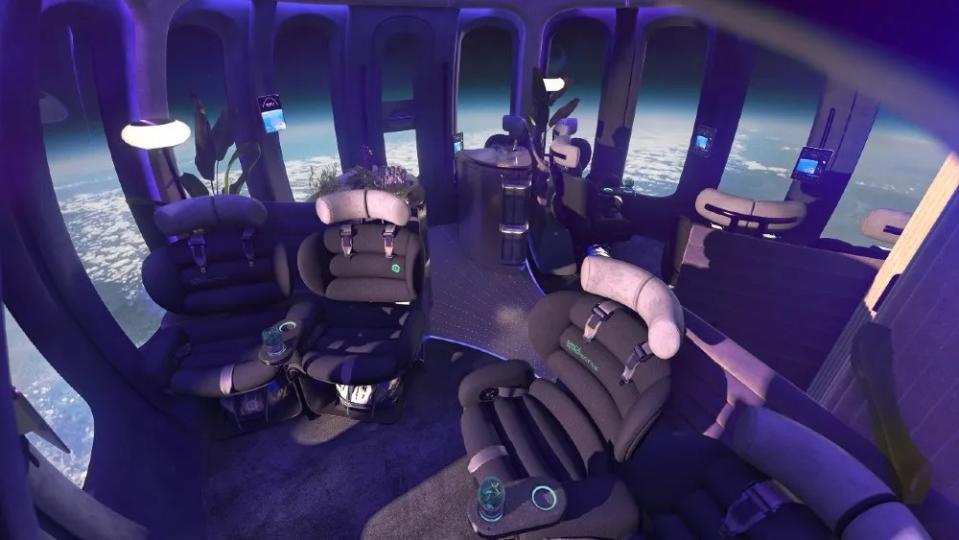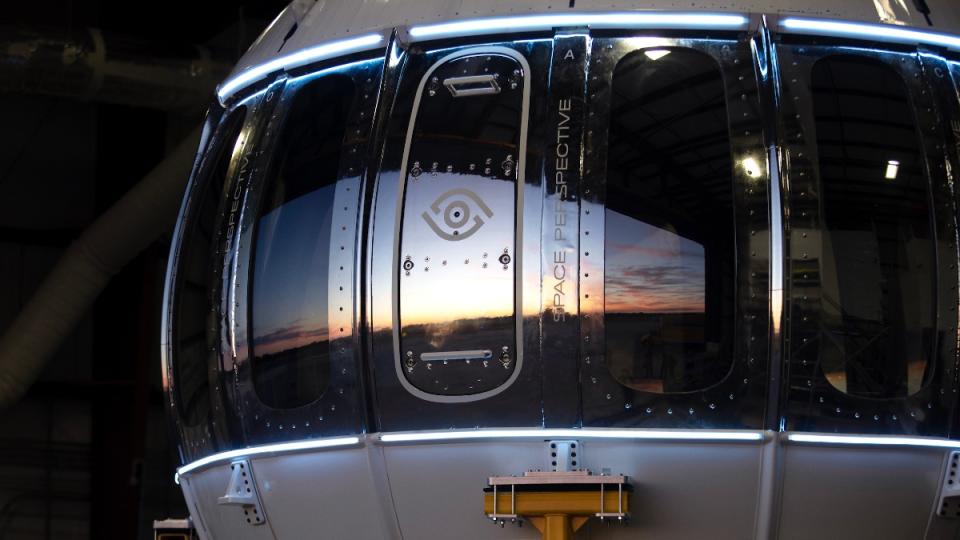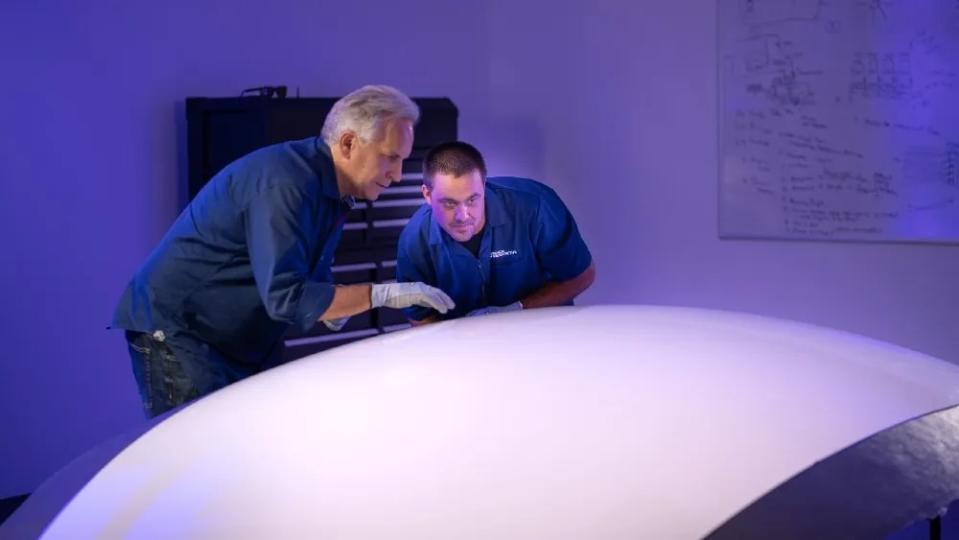The World’s Largest New Tourist Spacecraft Is Swankier Than Your Favorite Cocktail Lounge

- Oops!Something went wrong.Please try again later.
Space capsules are usually cramped spaces filled with blinking displays, backup systems, and just barely enough room for the astronauts. Space Perspective’s just-arrived Neptune capsule is more like a lounge or club, with custom recliners, a bar, and big windows, to enjoy the view.
The space-balloon tourism firm, which expects to make its first manned mission by the end of this year, is moving from concept to reality with the 16-foot diameter sphere, which has an internal volume of 2,000 cubic feet. The Florida company calls the new capsule the “largest-size human launch spacecraft in operation”—claiming it’s roughly twice as large as Virgin Galactic’s SpaceShipTwo and Blue Origin’s New Shepard, and four times the size of SpaceX’s Crew Dragon.
More from Robb Report
Jeff Bezos's Blue Origin Is Heading Back Into Space After More Than a Year
An Elon Musk Biopic Is Coming-and The Whale's Darren Aronofsky Is Set to Direct

Space Perspective’s capsule has a much different mission profile than the other rocket-based modes of transport. It will be competing with Virgin Galactic and Blue Origin on its tourist flights to the edge of space—though its 100,000-foot altitude ceiling is far lower than the other two, which approach 264,000 feet at supersonic speeds. Its giant-space balloon propulsion lifts and descends at about 12 mph during the roughly six-hour trip. Two other competitors, Zephalto and World View, are developing similar balloon/capsule tourism concepts.
Space Perspective’s journey from concept to functioning capsule prototype, which will be used to test equipment rather than carry people, involved tens of thousands of computations, building a composite manufacturing facility in house, and creating an interior that was both aesthetically pleasing to a high-end client but could also withstand the impact when the capsule splashes down in the ocean.

“We did 40 to 50 mockups on the interior and 100 simulated trials,” says Taber MacCallum, who co-founded Space Perspective with his wife, Jane Poynter, in 2019. “One of the most challenging parts was the floor engineering. When the sphere pressurizes, it wants to grow a bit, but as we go through the tropopause where it’s minus-80 degrees Celsius, it wants to shrink—and then grow again at the much hotter edge of space.”
MacCallum says the floor must also withstand the impact of a water landing as well as the shock of participants dancing as they sip cocktails and celebrate the Earth’s curve at altitude.

The engineering of the windows was also a challenge, partly to allow participants to see clearly in the intense sunlight on the edge of space, but also how they would congregate to see the views. “We first thought they’d all want their own windows, but then realized it’ll be as much about interacting with each other, so we set up the seats in two semicircles,” he says.
The capsule will undergo ground testing over the next four to six weeks, and then will start its first test flight, simulating the same altitude and conditions as future commercial flights. The flights include being picked out of the water by its ship, MS Voyager, which will also serve as the launchpad, with a mission-control facility inside for 42 people. “The capsule will have big instrumentation racks along with temperature and strain monitors, so it’s wired up pretty well—and they feed into computers which will be where the guests would normally be seated,” says MacCallum.

Following modifications, the next test capsule will be for human testing—with a finished luxe interior—which will take place before the first commercial flights. MacCallum didn’t want to give an exact timeline, but those could happen in 2025. “It will take place after we’ve proven its safe for commercial flight,” he says.
Eventually, the start-up plans to organize multiple flights per week along the Florida coast from its headquarters on Cape Canaveral, with long-term plans to set up facilities in other parts of the world.
The company said in July it has sold more than 1,600 seats, representing about $200 million in sales. In today’s release, Space Perspective said it closed on its current round of investment efforts. “All current investors have reinvested, demonstrating huge excitement about the company,” said a spokesperson.
Best of Robb Report
Sign up for Robb Report's Newsletter. For the latest news, follow us on Facebook, Twitter, and Instagram.

